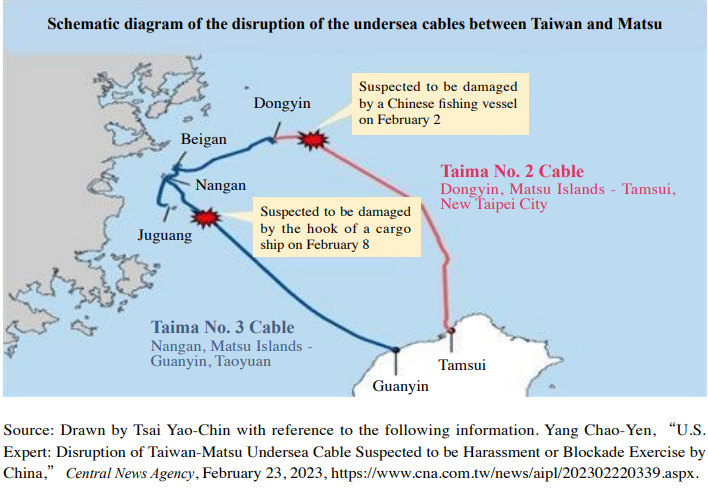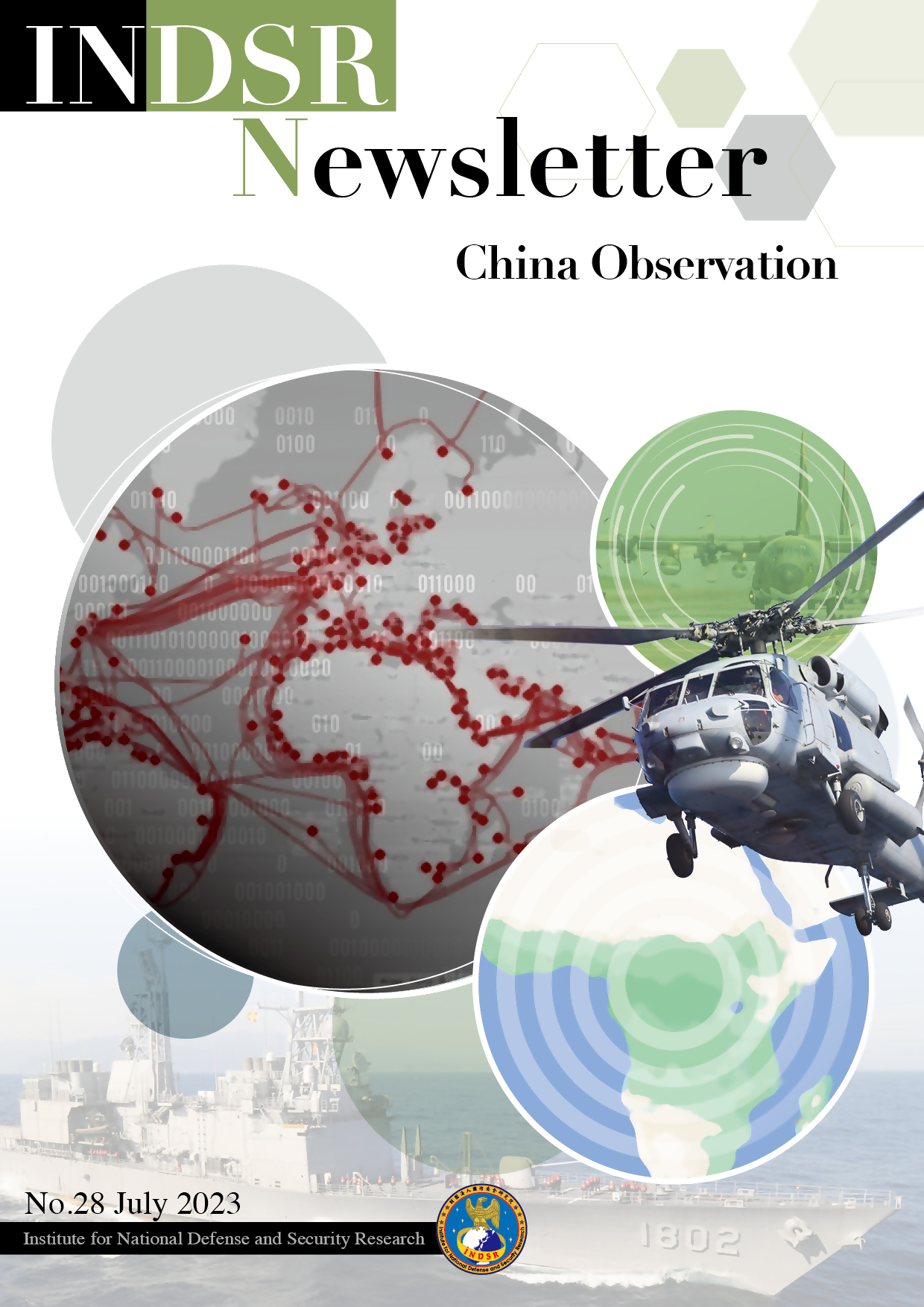The Influence of Matsu Undersea Cable Interruption on Taiwan’s National Defense Security
2023.08.28
Views
254
PDF link:
1. News Highlights
On February 2 and 8, 2023, two submarine communication cables connecting Taiwan and Matsu were severed and damaged respectively by CCP fishing vessels and unidentified ships (as shown in Figure 1). This incident resulted in local landlines, mobile communication, broadband Internet, and Multimedia on Demand (MOD) services being blocked, rendering communication impossible. After the cable disruption, the operation of government agencies, financial transactions, medical services, and transportation were affected. The cable repair vessel entrusted by Chunghwa Telecom completed the repair in the Matsu sea area by the end of March, restoring normal communication between Taiwan and Matsu.[1] In this age of advanced internet information, the use of mobile phones and the internet is essential in people's lives. The disruption of the submarine cable between Taiwan and Matsu not only caused inconvenience to the public but also affected the operation of government agencies. Particularly, it caused damage to military communication resilience, affecting combat readiness training, highlighting the crucial role that the stability of submarine cables plays in the operation of offshore islands.
Figure 1: Schematic diagram of the undersea cables disruption between Taiwan and Matsu

2. Security Implications
Currently, Taiwan has four submarine cable landing stations located respectively in Touchen, Yilan, Tamsui and Bali in Taipei, and Fangshan, Pingtung. Taiwan must connect to the global telecommunications network through the 14 submarine cables at these four landing stations. These cables link Taiwan to Europe, America, Japan, Hong Kong, and Singapore, further connecting to the global network and offshore islands of Kinmen, Matsu, and Penghu.[2] Submarine cables are Taiwan's primary communication network for the internet, information transmission, and international financial trade with the international community. If Taiwan's submarine cables are damaged by natural disasters or deliberate human actions, even though it won't affect Taiwan’s internet connection with other countries, the impact on Taiwan would still be substantial. Therefore, comprehensive backup measures should be established.
2-1. Impact of Internet Cutoff on Offshore Island Operations
“Combat relies on command, and command relies on communication.” If the CCP were to launch an attack on Taiwan, it would undoubtedly first use cyber troops, electronic warfare, and missiles to target Taiwan’s military airports, ports, high mountain, coastal radar stations, missile positions, communication stations, command centers, and other critical facilities. The aim would be to paralyze Taiwan’s command-and-control system, rendering Taiwan’s military unable to fully deploy its capabilities. Although the Republic of China Armed Forces have microwave and radio communications to take over command communication, manage enemy situations, and command troops, these methods cannot provide comprehensive coverage and their effectiveness is limited.[3] Submarine fiber-optic cables from Chunghwa Telecom remain one of the primary communication means for offshore islands. Apart from wireless internet, the operation mechanism of combat command also heavily relies on satellite networks. The ability to respond to major incidents, establish an effective backup system, and support military operations is a crucial aspect of cyber resilience.
2-2. Impact of Internet Cutoff on Social Functioning and Morale
This incident rendered island residents unable to access the internet. In addition, if government operations, financial transactions, and immigration police checks were affected, the severity would escalate to a level of national security concern. From the news, we can see that the operation of government systems was not significantly impacted, but people reported their inability to receive messages on their phones. Considering that most people nowadays use mobile internet for online shopping, financial payments, stock market transactions, and withdrawing cash from ATMs, the security impact on financial transactions cannot be underestimated. Currently, the Mini Three-Link Transportation mechanism is in effect on the offshore islands, where police and customs officers have to check personnel entries and exits through the Ministry of Interior's police system to prevent potentially dangerous individuals or entities from entering the country opportunistically. With the interruption of internet communications, only manual systems can be implemented, which significantly reduces efficiency and could potentially create security loopholes.
3. Trend Analysis
3-1. The CCP will continue to use similar means to undermine Taiwan’s cyber resilience
In recent years, the CCP has been taking gray zone actions to test Taiwan’s air defense measures and increase the burden on Taiwan’s air defense readiness. Since September 2020, the CCP has regularly dispatched aircraft and ships to intrude into Taiwan’s sea and airspace. The number of intrusions by the CCP aircraft into the Taiwan Strait multiplied in 2021 and 2022. In 2022, the CCP frequently harassed the offshore islands with drones, posing severe challenges and threats to the front-line combat troops. The CCP's gray zone operations also include the use of civilian resources. Since 2019, Chinese sand dredgers have been entering the surrounding sea areas of Matsu and Kinmen illegally for sand dredging. According to the Coast Guard Administration, the number of expulsions of sand dredgers violating the border soared from 600 times in 2019 to nearly 4000 times in 2020.[4] The massive illegal sand dredging by Chinese sand dredgers around the offshore islands has exposed cables buried two meters under the sea, increasing the risk of cable damage.
If the CCP were to employ various methods to cut off our international submarine cables, it would force Taiwan to lose international communication in the short term, preventing important international messages from being transmitted and tracked, causing speculation and panic among the public.[5] Although this incident occurred in the offshore islands, the two consecutive submarine cable interruptions in February have already affected the lives of military personnel and civilians on the island. The CCP is testing Taiwan’s cyber resilience by using various gray zone tactics, and future developments are worth continuous observation.
3-2. Establishing Backup Mechanisms and Strengthening Network Resilience
Protecting key infrastructure is paramount for national security. Taiwan should proactively strengthen the means of protecting vital targets and perfect various backup mechanisms. In addition to continuing the construction of the fourth and fifth submarine cables between Taiwan and Matsu, Taiwan’s ST-2 Commercial Satellite is expected to serve until 2029.[6] Furthermore, the domestic internet, including fiber optic lines and nearly 110,000 privately-owned base stations, is fully established.[7] The government can integrate the information technology capabilities of both military and civilians to develop low-orbit communication satellites. On the other hand, in recent years, many advanced countries have used drones not only as a means of attack and reconnaissance during war but also as communication relay stations. In 2022, Taiwan established the Asia UAV AI Innovation Application R&D Center, combining the capabilities of industry, government, and academia to promote the drone industry, making drone communication relay stations a focus of research and development. Given that submarine cable disruptions had no impact on the communication network of the main island, drone communication relays can be used for disaster relief (such as during the 921 earthquake) and interconnection between military operational units, thereby enhancing the resilience of Taiwan's communication system.
3-3.Learning from the Russo-Ukrainian War and Developing Low-Orbit Satellites
Due to different transmission bandwidths, submarine fiber-optic cables are the primary means of communication for outlying islands, with microwaves serving as the first backup and satellites as the second. Additionally, affected by the weather, cable bandwidths are transmitted in TB, microwave communications in GB, and satellite in MB. Although the bandwidth of currently developed low-orbit satellites is not wide enough, they can ensure that communication will not be completely disrupted.[8] During the Russo-Ukrainian war, Ukraine's important communication infrastructure was attacked by Russian military forces, affecting operational command. Ultimately, through Starlink, a low-orbit satellite network provided by the American space service company SpaceX, the Ukrainian government and military could carry out command operations and maintain government operations. Ukrainian forces could resist continuous Russian offensives during the war, and on the deadlocked eastern Ukrainian front, they could obtain enemy targets and positions and launch attacks with drones.[9]
The government of Taiwan has planned to set up more than 700 locations domestically and three foreign sites, installing geostationary satellite equipment to verify the feasibility of geostationary satellite communication services.[10] Also, in response to future trends, Taiwan Space Agency (TASA) will develop low-orbit communication satellites to strengthen Taiwan’s network resilience with the plan to launch a communication experimental satellite in 2025 and 2026 respectively.[11] In the private sector, Foxconn Technology Group has joined hands with domestic technology industries and completed its first self-developed low-orbit satellite, Pearl, which is expected to be launched in 2023.[12] As the industry, government, and academia actively research and develop low-orbit satellites, the government should take the lead in integrating relevant departments to include low-orbit satellites in Taiwan's defense operations.
Given insufficient numbers of low-orbit satellites, Taiwan can also consider how to maintain network smoothness by relaying satellite signals via Japanese cables through international cooperation. If the US military assists Taiwan’s military in connecting to the Starlink low-orbit satellite network, Taiwan’s military has to be well-prepared in terms of personnel training and hardware facilities.
(Originally published in the 81th “National Defense and Security Biweekly”, June 9, 2023, by the Institute for National Defense and Security Research.)
(The contents and views in the assessments are the personal opinions of the author, and do not represent the position of the Institute for National Defense and Security Research.)
[1] Chiang Ming-Yen, “One Taiwan-Matsu Undersea Cable Was Repaired Earlier than Expected. Chunghwa Telecom Says Taiwan-Matsu Communications are Back to Normal,” Central News Agency, March 31, 2023, https://www.cna.com.tw/news/afe/202303310279.aspx.
[2] Chung Li-Hua, “Taiwan Connects 14 International Submarine Cables. Officials: China's Network Attacks Make Them Enemies of Other Countries,” The Liberty Times, April 15, 2023, https://news.ltn.com.tw/news/politics/breakingnews/4271671.
[3] Lu Chiung-Chang, “Matsu Submarine Cable Disruption: Chiu Kuo-Cheng Admits It’s A National Security Crisis,” NOWnews, https://www.nownews.com/news/6056957.
[4] Tseng I-Hsuan, “Reuters: China’s Sand Dredgers Entered Taiwan Waters, Starting A New Type of Warfare,” Central News Agency, February 6, 2021, https://www.cna.com.tw/news/firstnews/202102060091.aspx.
[5] Lee Hsi-Ming, How Taiwan Can Win (Linking Publishing Company, New Taipei City, September 2022, P. 207.
[6] Lin Shu-Hui, “CHT and SingTel to Launch A Third Satellite,” Commercial Times, February 7, 2023, https://wantrich.chinatimes.com/news/20230227900003-420101.
[7] “Statistics on Mobile Communication Business Base Stations,” National Communications Commission, March 2 ,2023, https://www.ncc.gov.tw/chinese/opendata_item.aspx?menu_function_sn=208.
[8] Chiang Ming-Yen and Su Ssu-Yun, “CHT Strengthens Network Resilience with Sea Cable, Microwave, and Satellite as A Backup for Each Other,” Central News Agency, April 9, 2023, https://www.cna.com.tw/news/afe/202304090016.aspx.
[9] Alan Chen, “Starlink Application in the Russo-Ukrainian War Highlights the Importance of Low Orbit Satellites, What are the Implications for Taiwan?” TechNews, July 27, 2022, https://technews.tw/2022/07/27/leo-satellites-could-be-vital-for-taiwan-in-potential-conflict-with-china/.
[10] Chiang Ming-Yen and Su Ssu-Yun, “The Landing of the Low Earth Orbit Satellite Proof of Concept (PoC) is Expected. The Industry Says Local-foreign Cooperation Has A Tacit Understanding,” Central News Agency, October 22, 2022, https://www.cna.com.tw/news/afe/202210220026.aspx.
[11] Wu Po-Hsuan, “Taiwan’s First Low-orbit Communication Satellite Aims to be Ready for Launch in 2025,” The Liberty Times, February 26, 2023, https://news.ltn.com.tw/news/life/paper/1569091.
[12] Chung Jung-Feng, “Foxconn Technology Group’s Low-orbit Satellites to be Launched in the 4th Quarter, AI Server Revenue Share is Expected to Rise,” Central News Agency, May 11, 2023, https://www.cna.com.tw/news/afe/202305110200.aspx.


